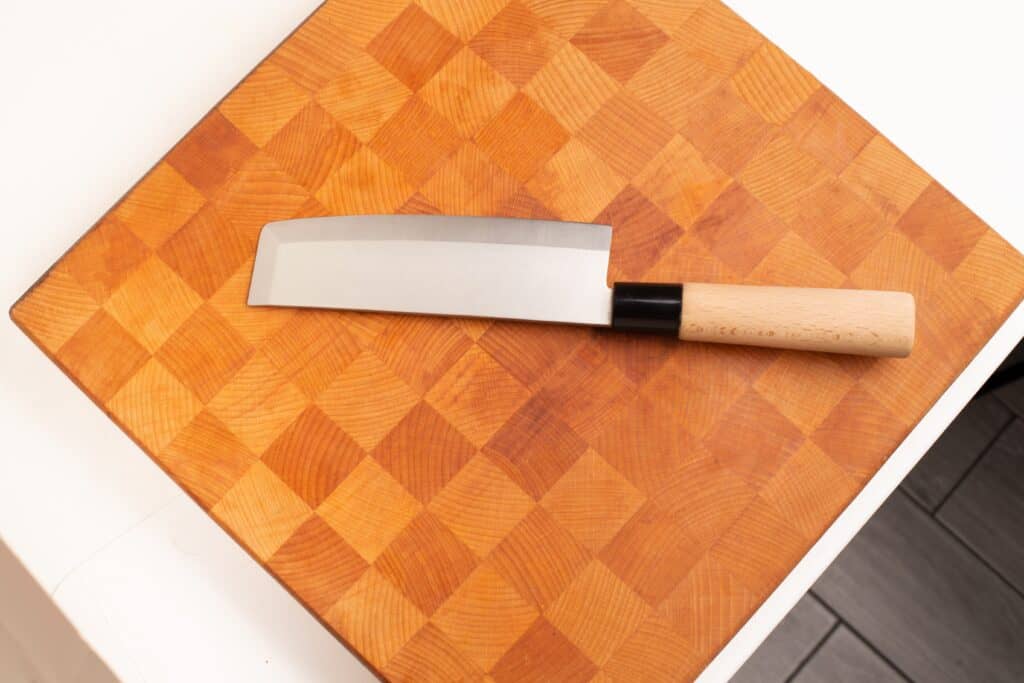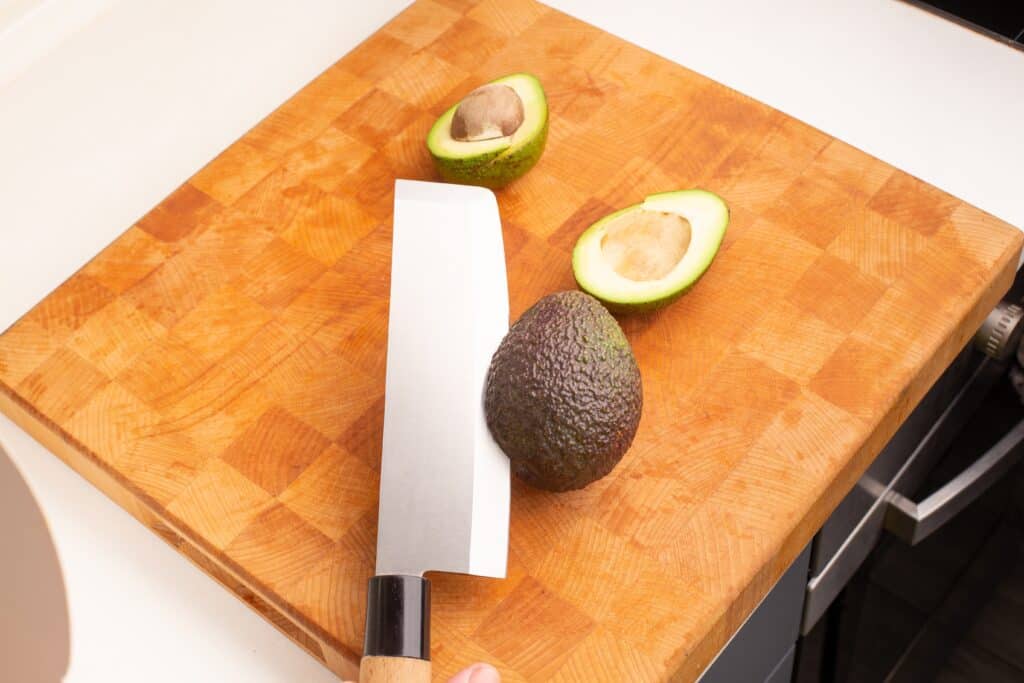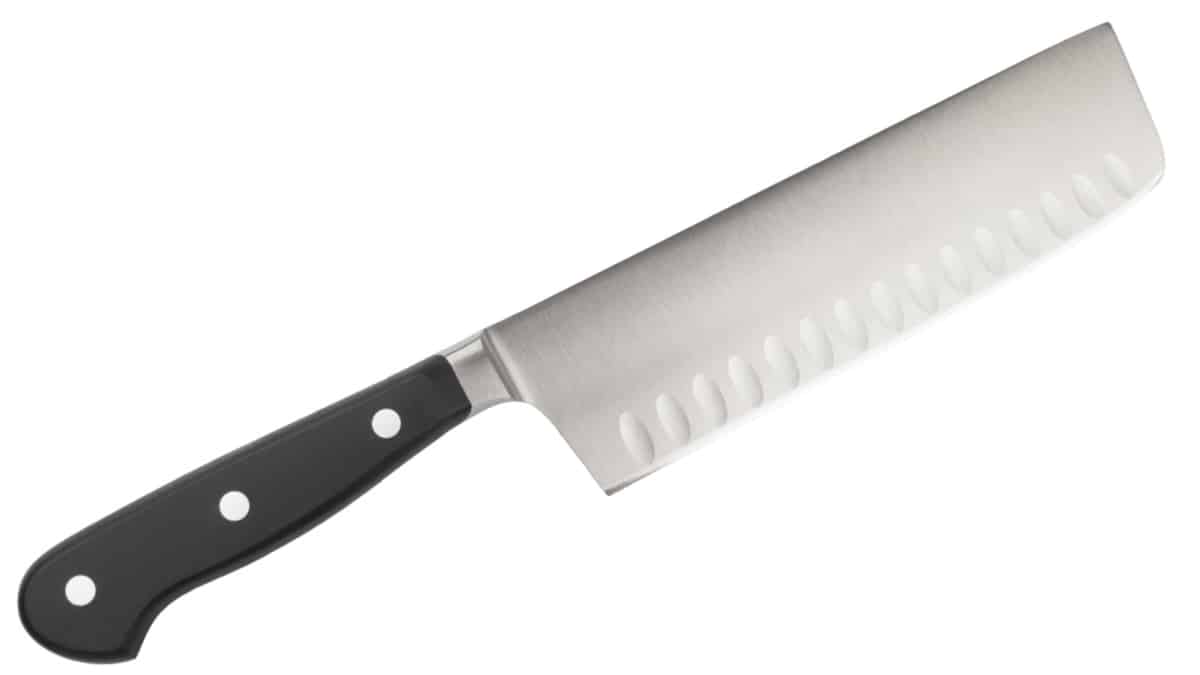When you visit a merchant by clicking a link on this site we may make a commission on anything you buy (at no additional cost to you). Affiliate programs and affiliations include, but are not limited to Amazon Associates and the eBay Partner Network.”
A Nakiri knife is a specific type of Japanese kitchen knife designed primarily for cutting vegetables and fruits. Its distinctive features include a thin, broad rectangular blade, a straight cutting edge, and a flat, blunt tip. This knife is popular among home cooks and vegetarians in Japan due to its exceptional performance when it comes to chopping, slicing, dicing, and mincing vegetables and fruits quickly and efficiently.
The Nakiri knife’s flat edge and straight cutting edge enable it to make complete contact with the cutting board, resulting in cleaner cuts. This design also ensures minimal damage to the ingredients, preserving their freshness and integrity. While using a Nakiri knife may require some adjustment, you’ll find that sliding the knife forward or backward works better than rocking it.
Originating from 17th century Japan, the Nakiri knife has become an essential tool in many kitchens around the world. Although its primary purpose is for processing vegetables and fruits, some enthusiasts have found it useful for other kitchen tasks as well. The blade’s thinness and sharpness make it an excellent tool for precision cutting, and its rectangular shape offers a unique and aesthetically pleasing look in the kitchen.
What is a Nakiri Knife
A Nakiri knife is a type of Japanese knife that specializes in cutting vegetables. It features a rectangular blade and a straight cutting edge that enables precise and efficient chopping, slicing, dicing, and mincing of vegetables and fruits. It is widely used in Japan by both home cooks and vegetarians due to its effectiveness and ease of use.

Although the Nakiri knife has a double bevel, its blade is thin, which makes it lightweight and easy to maneuver. This allows the user to work quickly and efficiently in the kitchen. The thin blade also helps in achieving even slices, making it an excellent tool for tasks such as ribboning or julienning vegetables.
The flat edge of the Nakiri knife allows for more complete contact with the cutting board, resulting in cleaner cuts than with other types of knives. This design ensures that the user can make precise and even cuts without much effort.
In comparison to other knives, the Nakiri knife stands out due to its versatility. Though designed primarily as a vegetable processing knife, it can also handle other cutting tasks in the kitchen. The thin, sharp blade combined with the lightweight design ensures that this knife has a place in any kitchen.
Overall, the Nakiri knife is a valuable addition to any kitchen, especially for those who frequently work with vegetables. Its unique design, straight cutting edge, and lightweight construction make it an efficient and precise tool for many cutting tasks.
Design and Features
Blade Length and Material
Nakiri knives generally have a blade length of 5 to 7 inches, which is ideal for most kitchen tasks. The blade material can vary, but the most common materials are stainless steel and high-carbon steel. Both materials offer a thin blade that maintains sharpness for efficient and accurate cutting.
Handle and Grip
The handle of a Nakiri knife is another important aspect of its design. Many Nakiri knives have a long handle, which can be either a Western-style handle or a traditional Japanese handle, depending on the brand and design. The handle materials can vary, but the goal is to provide a comfortable grip and ensure ease of use during food preparation.
Straight Edge and Flatness
The straight edge and flatness of a Nakiri knife’s blade are unique features that set it apart from other types of knives. The flat edge allows the blade to make complete contact with the cutting board, which results in clean cuts and easier control of the knife. The straight edge allows for an efficient up-and-down motion when cutting, aiding in precision and speed.
Weight and Balance
A Nakiri knife should have a lightweight design and be well-balanced, making it comfortable to use for extended periods. This helps users maintain control and stability when using the knife, ensuring accurate cuts and efficient food preparation.
Double Beveled Blade
Most Nakiri knives have a double-beveled blade, also known as a ryoba blade. This means that both sides of the blade are sharpened, making the knife suitable for both left-handed and right-handed users. The double bevel also helps create cleaner and more precise cuts.
Rounded Tip
Another distinguishing feature of a Nakiri knife is its rounded tip. Unlike other knives that have a sharp point, the Nakiri knife’s rounded tip ensures safety and prevents accidental cuts when cutting vegetables or other ingredients.
Special Features
Some Nakiri knives have special features, such as a hammered finish on the blade. This not only adds a unique visual appeal but also helps create clean cuts by reducing the surface area that comes into contact with food items.
Maintaining Your Nakiri Knife
Proper maintenance of your Nakiri knife is essential to keep it in good condition and extend its lifespan. Regularly sharpening the knife ensures that the blade remains sharp for effective cutting. Taking care of a Nakiri knife is a worthwhile investment, as these knives are designed to provide efficient, clean cuts and long-lasting performance.
Nakiri Knife Vs. Other Knives

Nakiri Vs. Santoku
The Nakiri and Santoku knives are both versatile Japanese knives that can be used for various cutting tasks, but they differ in design. The Nakiri knife is known for its thin, rectangular blade with a straight cutting edge, making it perfect for chopping, slicing, and dicing vegetables with ease and precision. On the other hand, a Santoku knife features a more rounded tip and a slightly curved edge, giving it more versatility when cutting different ingredients.
Nakiri Vs. Usubu
While both the Nakiri and Usuba knives are renowned for their proficiency in cutting vegetables, they hold distinct features that cater to different tasks and skill levels. The Nakiri knife, known for its double-bevel, thin, rectangular blade, enables efficient chopping, slicing, and dicing with precise uniformity. Its thin, flat blade allows for clean, straight cuts, making it a suitable choice for beginners or casual cooks. Conversely, the Usuba knife, often used by professional chefs, features a single-bevel blade that allows for extremely precise and thin slicing, ideal for intricate cuts. Its heavier and thicker blade demands more skillful handling, making it a perfect fit for experienced chefs.
Nakiri Vs. Meat Cleaver
A Nakiri knife is not designed to handle heavy-duty tasks like cutting through bones or thick meat, whereas a meat cleaver is a much heavier and sturdier knife specifically made for this purpose. Nakiri knives are lighter and have a flatter, thinner blade, suitable for delicate vegetable cuts.
Nakiri Vs. Chinese Cleaver
The Nakiri knife and Chinese cleaver may appear similar due to their rectangular shapes, but the Chinese cleaver has a much wider and heavier blade. This heft allows the Chinese cleaver to handle a variety of chopping tasks, including cutting through small bones. Despite their differences, both knives excel at chopping vegetables and can have a place in your kitchen depending on your needs.
Nakiri Vs. Vegetable Cleaver
A vegetable cleaver is also designed for processing vegetables, like a Nakiri knife, but often has a slightly different shape and size. Vegetable cleavers may have double bevels, making them suitable for more intricate tasks. While both knives are great for chopping vegetables, Nakiri knives are typically lighter and more specialized for this purpose.
Complementary Knives
While the Nakiri knife is an excellent tool for preparing vegetables, it’s essential to have other knives in your kitchen to handle various tasks. For instance, a Santoku knife can provide versatility with its rounded tip, and a meat cleaver can handle heavy-duty cuts. Consider adding a selection of complementary knives to your collection based on your cooking habits and preferences.
Finding the Right Nakiri Knife
When selecting a Nakiri knife, look for a reliable brand and high-quality materials. Japanese knives are often made with attention to detail and precision, making them a great option. A reputable brand, such as Yoshihiro, offers a variety of Nakiri knives with different price points and features. Choose one that fits your needs and budget, and enjoy the benefits of using a Nakiri knife in your kitchen.
Using a Nakiri Knife
Cutting Techniques
A Nakiri knife is a specialized tool designed for efficient vegetable cutting, with a flat and straight edge that ensures clean, precise cuts. The recommended cutting technique for using a Nakiri knife involves an up-and-down motion, as opposed to the rocking motion often used with a chef’s knife. This technique minimizes effort and maximizes the sharpness of the blade, creating uniform slices and reducing the risk of accordion cuts. When using a Nakiri knife, adopt a comfortable grip by placing your palm on the butt of the handle and wrapping your fingers around it. Be sure to maintain a “claw” with your non-cutting hand for added safety.
Ideal Foods for Nakiri Knives
Nakiri knives excel at cutting various types of fresh vegetables and fruits. They are ideally suited for chopping onions, dicing cabbage and kale, mincing herbs, and preparing root vegetables. Nakiri knives can also be used for cutting soft cheeses, peeling fruit, and slicing ripe fruits and vegetables without causing damage.
Preparing Popular Dishes
The versatility of a Nakiri knife makes it ideal for preparing various popular dishes. For example, use your Nakiri knife to create thin, uniform slices of potatoes for scalloped potatoes, julienne carrots, and bell peppers for stir-fries, or thinly slice onions for caramelizing. A sharp Nakiri can also easily cut through dense ingredients like cabbage or kale, making it perfect for shredding ingredients for coleslaw or salads.
Kitchen Safety
When using a Nakiri knife, as with any sharp kitchen tool, safety is of utmost importance. Here are some safety tips to keep in mind:
- Always use a stable and non-slip cutting board to prevent unwanted movement while you chop.
- Cut away from your body, never towards it.
- Always store your Nakiri knife in a designated knife rack or blade guard when not in use.
- Keep the knife blade clean, dry, and sharp to prevent accidental slipping during use.
By adhering to proper cutting techniques, selecting suitable ingredients, and observing kitchen safety, you can make the most of your Nakiri knife and enhance your overall culinary experience.
Do Sheepsfoot Blades Have A Purpose? (Cuz They’re Ugly…)
Spetsnaz Machetes – Blades Of The Russian Special Forces
What Is The Actual Purpose Of A Spear Point Knife Blade?
CRKT CEO Review – Coolest, Most Worthless Knife Ever?
How Sharp Is A Scalpel? (Is It Sharper Than A Razor?)
Can You Shave With A Knife? (Yes, Here’s How)
When you visit a merchant by clicking a link on this site we may make a commission on anything you buy (at no additional cost to you). Affiliate programs and affiliations include, but are not limited to Amazon Associates and the eBay Partner Network.”







